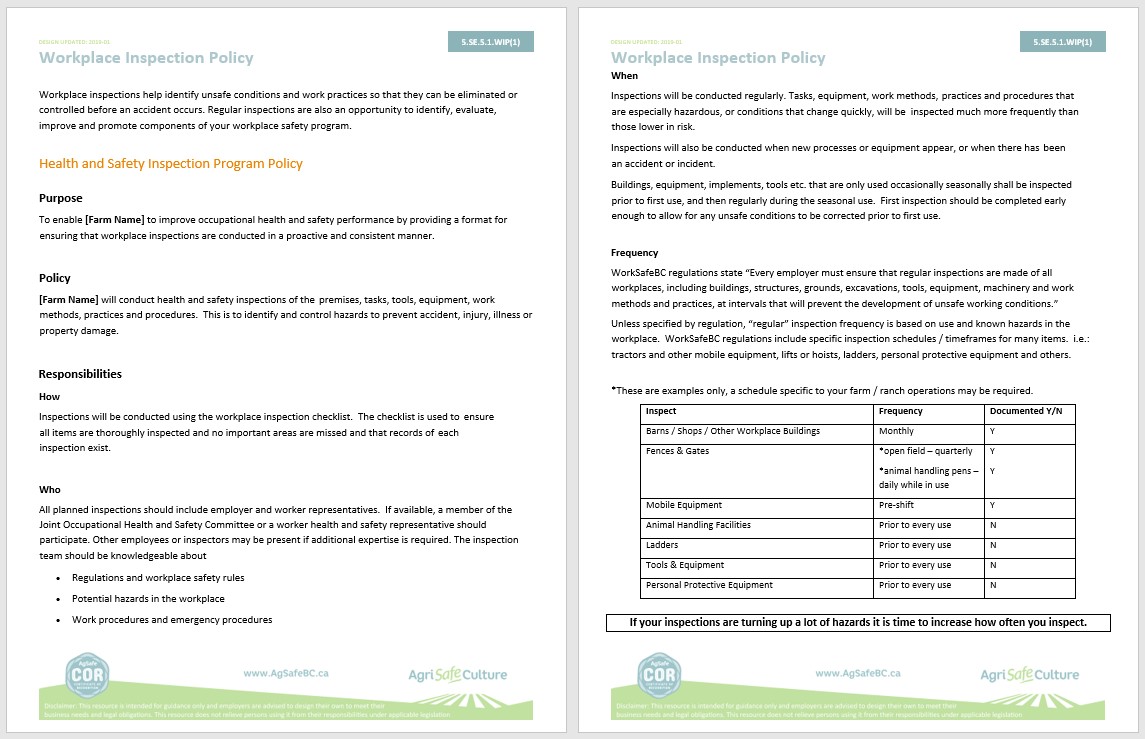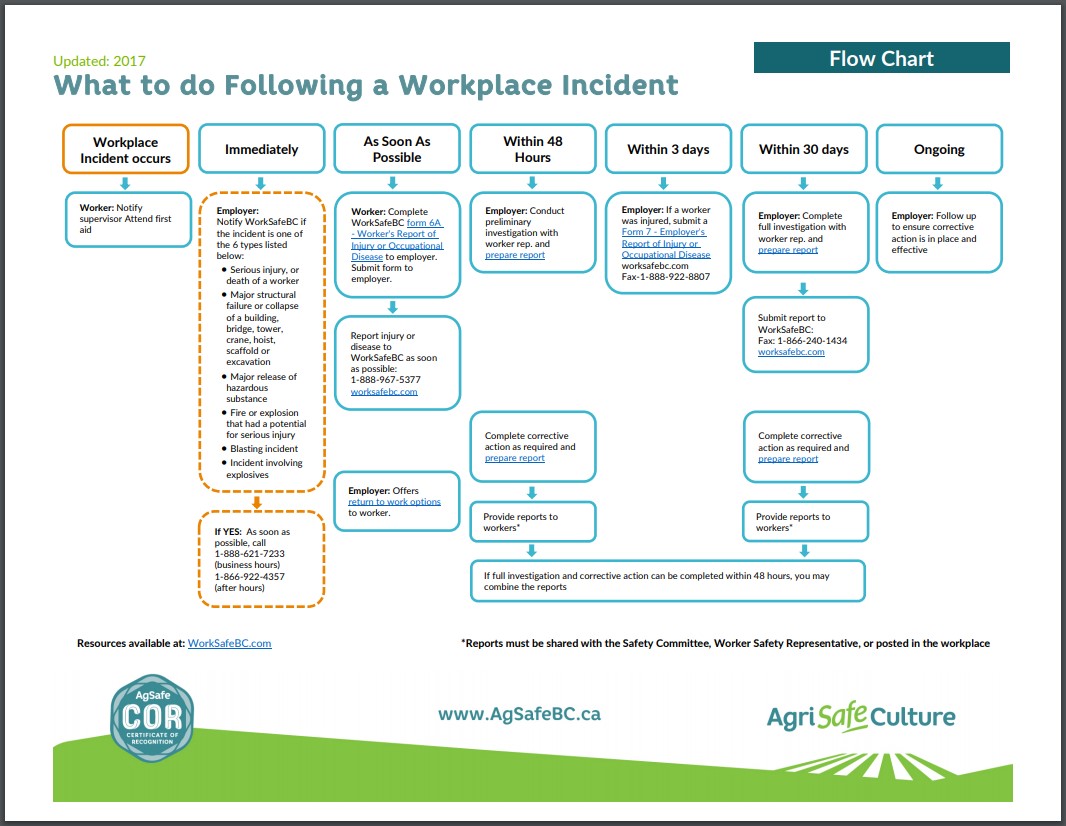Foundations of Safety
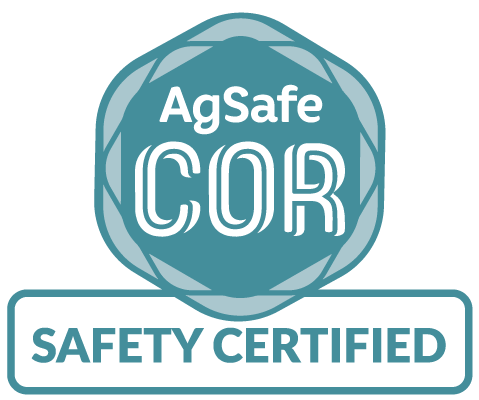
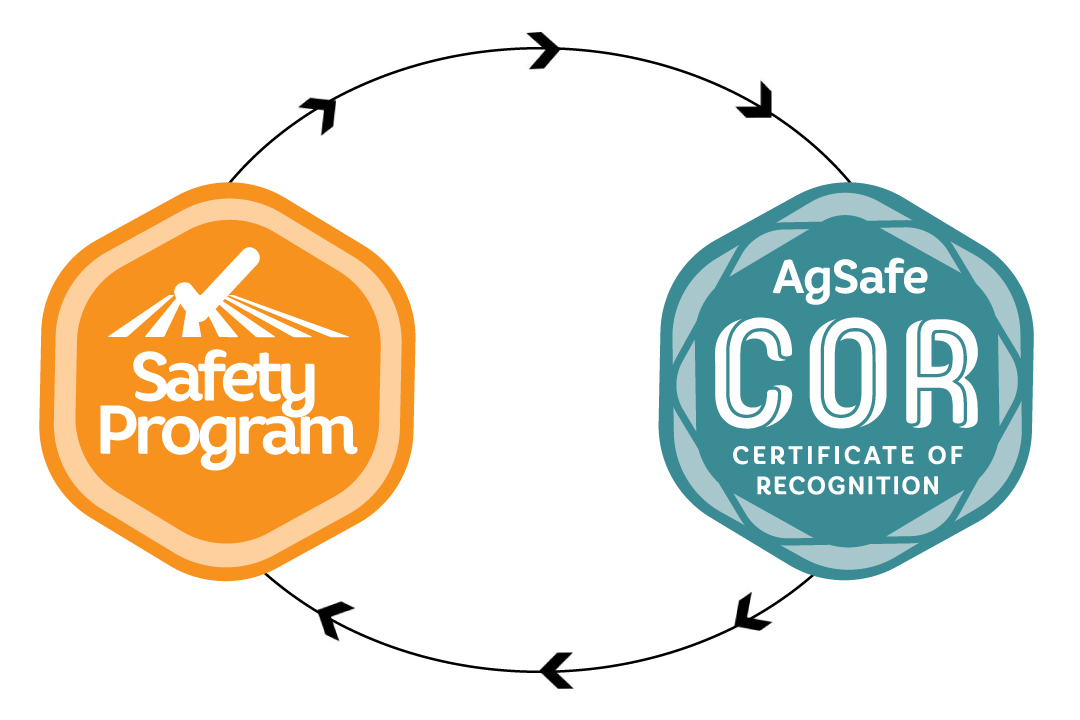
Safety education and consultation is what we do at AgSafe BC. That’s why we are introducing a short eight-part series about the foundations of workplace safety.
While much of the information in this series applies to smaller agricultural producers, the series in general is intended to highlight the foundations of a robust workplace health and safety program regardless of operation size.
Is your Occupational Health and Safety program paying off?
The Certificate of Recognition (COR) program is an incentive program that recognizes and rewards employers for implementing an effective Occupational Health and Safety (OHS) program and demonstrating a commitment to workplace health and safety.
Participation in the COR program is voluntary, and for as few as 1 – 2 hours per month you could achieve COR certification and claim the benefits associated with being COR certified, which include:
- Increased confidence in meeting regulatory requirements
- Demonstration of commitment, leadership, and dedication to managing risks to people on site
- Competitive advantage when hiring employees because COR certification instills trust
- Protects the operation
- Annual incentive payments and proven lower claims costs
Examples of potential incentive payments*:
| Farm Type by Commodity | Classification Unit | Base Rate (2020) | Assessable Payroll | Potential Incentive |
|---|---|---|---|---|
| Ranch | 701022 | $5.28 | $163,000 or less | Lesser of $1000 or 75% of premium |
| Orchard | 701017 | $2.66 | $450,000 or less | Lesser of $1000 or 75% of premium |
| Berry | 701003 | $1.24 | $775,000 or less | Lesser of $1000 or 75% of premium |
| Dairy | 701005 | $3.03 | $375,000 or less | Lesser of $1000 or 75% of premium |
| Vegetable Farming (Field) | 701025 | $2.76 | $295,000 or less | Lesser of $1000 or 75% of premium |
| Poultry | 701020 | $1.73 | $700,000 or less | Lesser of $1000 or 75% of premium |
| Horse Ranching | 701023 | $5.24 | $170,000 or less | Lesser of $1000 or 75% of premium |
* Eligibility requirements exist, more details can be found here: https://www.worksafebc.com/en/health-safety/create-manage/certificate-recognition/incentives
You can determine your ROI by using the COR Safety Ready self-assessment tool. Enter and track your unique details here: http://safetyready.agsafebc.ca/roi
Need help?
- AgSafe BC has agriculture-experienced, qualified, professional health and safety consultants and advisors available throughout the province. AgSafe services and resources are free of charge to our levied members.
- Contact AgSafe BC at any time through our contact page at: http://agsafebc.ca/contact-us/ or by calling toll-free 1-877-533-1789.
What should I do next?
- Register for the COR program via this link http://agsafebc.ca/cor/cor-registration/
- Share this series with family and friends and make it a community effort
Leadership and commitment is a good place to start when building your safety system. In this article we discuss what a commitment to safety looks like and how you can involve your workers and family members.
How to demonstrate leadership and commitment
Engaging workers in the development, implementation and review of a workplace safety program shows leadership and commitment. A strong Occupational Health and Safety policy is your promise as the employer or owner to protect your workers, and other site visitors from harm. You want them to know that their safety is as important to you as production, and that you are willing and able to take steps to prevent a serious injury or the death of any individual.
AgSafe has developed OHS policy templates that you can use as a starting point:
Click here
The templates are designed to be modified to suit different needs, but before making any significant changes discuss them with your AgSafe BC safety advisor or regional safety consultant. If you haven’t met your consultant or advisor, contact our office. AgSafe consultants and advisors are qualified hand-picked agriculture-experienced health and safety professionals. Their services are free of charge to AgSafe members in all regions of B.C.
Things to consider
Your OHS policy, which is your safety promise to your family, friends and workers, may include:
- Statement of owner/organizational responsibility to:
- Provide a safe and healthy workplace
- Set goals and timelines for achieving safety standards and implementing a full safety program
- Develop the safety program in consultation with AgSafe to meet those goals and deadlines
- Confirmation of your commitment to:
- Value worker participation in safety
- Provide resources to maintain and improve your safety program, such as training, instruction, demonstration and supervision
- Resolve identified issues promptly
- Review the statement of responsibility annually
- Be in compliance with regulations
- Make the policy known to workers, contractors and other on-site persons
- Description of the worker rights/responsibilities
- Right to know (about hazards and safety resources)
- Right to participate in terms of:
- Reporting of unsafe acts or conditions
- Using controls such as written instructions, universal signage and PPE
- Assisting worker representatives or committee members
- Right to refuse work that is reasonably considered unsafe to the worker or others
- The signature of the owner or senior manager, and the current date
How to involve others in the process
You will benefit greatly by involving your workers and family early on. In some cases it is a requirement. Workers, along with the AgSafe team, can help you with the next steps that will be discussed in upcoming articles:
- Identifying hazards
- Assessing risks
- Evaluating and implementing controls
Next steps.
- Complete the Safety Policy Template for your location
- Complete the monthly meeting agenda and minutes
- Ensure you have “discussed the safety policy” as an agenda item
- Introduce your worker safety representative at the first safety meeting and identify that person at each successive meeting
Recognizing things that may hurt you, a worker or family member is the first step to hazard identification. The next step is to find a way to determine which hazards are most risky to workers and operating the business. Last, is to consider and implement various ways to stop or reduce the possibility of injury.
Developing a Hazard Identification, Risk Assessment and Control Process will help you build confidence in your ability to manage worker safety. Involving others in this process will make the outcome more successful and help get buy-in from your team.
Documenting the process is vital to success, and the first component of the process is a written policy. Apply the process to hazards related to your unique operation and document implementation. AgSafe safety advisors and consultants will support you along the way.
Things to consider
Remember that your Hazard Identification, Risk Assessment and Control Policy is an important promise.
The policy must include:
- Ways to check jobs or activities, equipment and conditions for hazards.
- A risk assessment strategy that helps prioritize hazards from most hazardous to least.
- A Control Implementation Plan based on the ordered list (found below) when considering how to stop or reduce the potential loss.
How to identify hazards, prioritize in terms of risk, and determine controls
How to Identify a Hazard
- Receive reports from workers or visitors.
- Discuss hazards during your safety talks.
- Use inspection reports.
How to Prioritize Risk
- Identify likelihood and consequence of the hazard.
- Compare to likelihood and consequences of other hazards.
- Select and implement controls based on most risky to least risky hazard.
How to apply controls
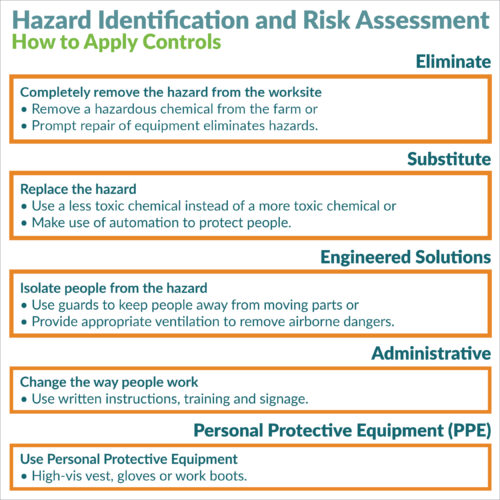
Monitoring and Evaluating Control Measures
- Make sure the controls selected are implemented as planned.
- Determine whether they are effective.
- Look out for hazards that may be introduced by the controls implemented.
AgSafe has developed OHS templates that you can use as a starting point:
Hazard ID Policy
Hazard and Site Specific Assessment
Hazard Reporting Form
Risk Assessment Matrix
Assessment of Tasks, Situations or Equipment and Risk Assessment Rating Matrix
Hazard Control Decision Process and Control Plan
These templates are designed for you to modify to meet your needs. However, before making any significant changes to a template, discuss proposed changes with an AgSafe safety advisor or regional safety consultant – they’ll help you stay in compliance and prepare you for COR certification at the same time *bonus*.
If you haven’t met your consultant or advisor, contact our office. AgSafe consultants and advisors are qualified hand-picked agriculture-experienced health and safety professionals. Their services are free of charge to AgSafe members in all regions of B.C.
How to involve others in the process
- Consult the people doing the work. They are often most familiar with the hazards - include yourself.
- Ask your workers about hazards and risks related to the work they perform – document it.
- Promote problem solving and safety discussions with your team.
In Part 1 – Leadership and Commitment, we discussed the importance of involving others in building your safety system. This is where that work begins to pay off and AgSafe safety professionals can help you with this too.
Next steps
Complete the Hazard Identification Policy for your location. Support the policy by documenting the hazards, risk assessments and controls. Include things you are already doing for full credit!
- Apply the policy to a number of hazards and use our Hazard Control Decision Process and Control Plan form. Keep the documentation for reference and to show due diligence.
- Discuss the following and complete a ‘Tool Box Talk’ or monthly meeting minutes:
- Hazard ID, risk assessment and control process.
- Identified hazards, risks and controls that are unique to your operation.
- Be sure to mention PPE requirements as part of the controls you use.
Our Regional Consultants and Safety Advisors are familiar with many hazards found in a variety of agricultural environments. Take advantage of their experience.
As a producer and employer you’ve made a promise to your family and workers to keep them and you safe. In Part 3 of Foundations of Safety we talk about how to develop safe work procedures for specific tasks; how to communicate and follow-through on those procedures; and how to engage others in determining what are the safest procedures for your particular workplace.
AgSafe has a “Safe Work Practice/Procedure Policy” template to get you started. Use this template to develop practice and procedure documents which are extremely helpful in providing training and instruction for how you want a task performed at your location. These documents may also form part of your due diligence documentation should something go wrong unexpectedly.
The Safe Work Practice/Procedure Policy might include:
- Commitment to develop and maintain SWPs for hazards identified unique to your operation.
- Communication plans to keep your workers informed of safe ways to do things, and records of those communications.
- A commitment to monitor how closely workers apply the SWP, through your valuable supervisors.
How to develop a Safe Work Procedure
There are many ways to do this. AgSafe’s safety advisors and regional consultants can discuss options that take advantage of practices you are already doing.
Downloading the Safe Work Procedure Template is the first step. Download
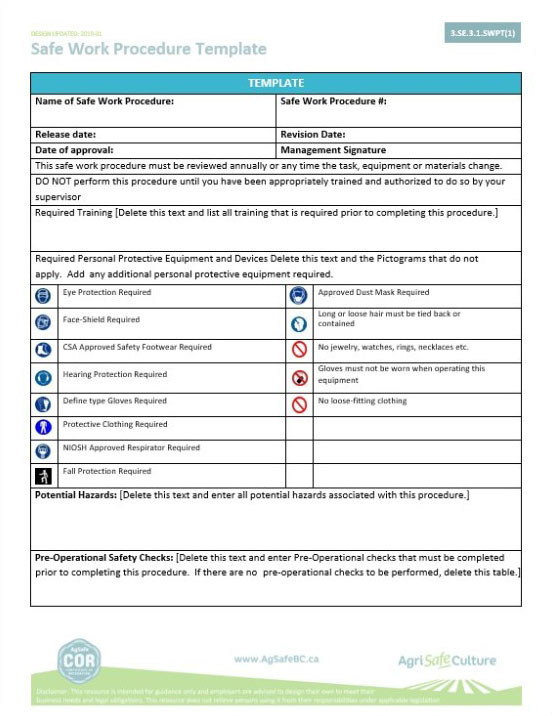
How to use the template
1. Describe the task.
2. Specify required training
3. Select proper PPE
Prior to providing task training, do the following.
- Describe potential hazards – These usually come from the hazard identification performed earlier, but may be amended or added to if equipment or conditions change. Include your experienced workers when completing this section.
- Perform Pre-Operational Safety Checks - This is an inspection so remember to record it.
Written Instructions
Tasks can be broken down into stages. Complete the three sections of the SWP according to each stage.
 3 Stages of Work
3 Stages of Work
1. Before you start
2. While you’re working
3. After you finish
Breaking the task down into a step-by-step process is a good way to explain it to others. Provide those steps as clearly and simply as you can, and be specific about what is expected. Provide relevant information to the farm manager or supervisor.
How to involve others in the process
- Have open and honest conversations with your workers. Their experience and input is valuable.
- Ask an AgSafe safety advisors or regional consultant.
- Have your worker safety representative or health and safety committee members contribute their ideas, and aim for agreement with them.
- Be sure to make a note on the form about who was involved in the creation, review or changes, and log the date.
Next steps
- Complete the Safe Work Practice/Procedure Policy for your location.
- Support the policy by documenting the Safe Work Procedure Template for your priority tasks.
- Discuss the following and complete a Tool Box Talk or monthly meeting minutes.
- Importance of following Safe Work Procedures of your operation.
- Recognize contributions of your workers to the Safe Work Procedures.
- Remind workers of the availability of these resources.
Our Regional Consultants and Safety Advisors are familiar with various agricultural Safe Work Procedures. Take advantage of their experience.
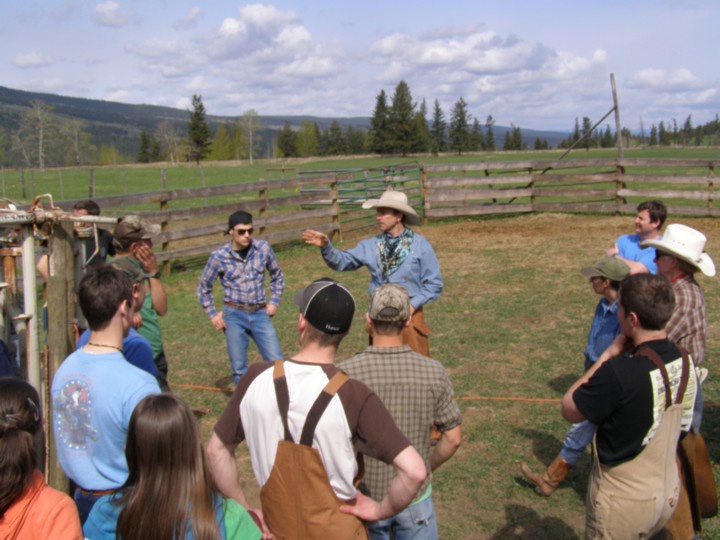 As a farm operator, you are probably already familiar with training others on how to do the job the way you like it done. In Part 4, we focus on how to document your training efforts for a variety of tasks and different types of employees - young or new workers versus established employees. When finished, this combined documentation should show that you are training appropriately for the task and in consideration of the individual employee.
As a farm operator, you are probably already familiar with training others on how to do the job the way you like it done. In Part 4, we focus on how to document your training efforts for a variety of tasks and different types of employees - young or new workers versus established employees. When finished, this combined documentation should show that you are training appropriately for the task and in consideration of the individual employee.
AgSafe has a 2-page “Training Policy and Requirements” document to get you started. It starts by indicating areas of responsibility for supervisors regarding training. Page 2 highlights the difference between informal (undocumented) and formal (documented) training procedures, including how to determine which type of training applies to different tasks based on risk level.
Supportive Documentation:
These documents are designed to support your management of training and instruction of workers, and should also align with the Training Policy and Requirements document.
- Training Requirements Chart
- Identifies what type of training you provide, informal/formal/certification, and what areas of training are included, orientation, emergency response, first aid.
- Worker Certification Record
- For each employee this lists the position held, types of certification required and an area to track certifications received and expiry dates as appropriate.
- Worker Orientation Checklist
- For each employee includes their signature for verification and is a list of items that should be covered when employees are new or returning to work.
- Training Record (WORD)
- This is a chart where the list of employee names appears down the side and their training areas are indicated according to the subject columns. This document is available in word or excel format
What to do:
- Review the Training Policy and Requirements Make applicable changes for your unique operation as needed.
- Ensure you complete the Worker Orientation Checklist for new and returning employees.
- Identify the training required for various tasks and record in either “Training Requirements Chart” or “Training Record”, or both.
- Review the documents at least annually to ensure they reflect changes in your operation and updates to the training that you have provided. Be sure to have a manager sign and date after reviewing.
How to involve others in the process
- Talk with workers about the hazards associated with the tasks they perform, and ask for their opinions regarding the risk levels of those tasks.
- Contact your AgSafe safety advisor or provincial consultant with questions or if assistance is needed.
- Document, document, document. It cannot be stressed enough that you should always document your activities regarding orientation and training of workers.
Next steps
- Add the training and instruction of workers policy to your Health and Safety program.
- Discuss the following and complete a ‘Tool Box Talk Log’ or monthly meeting minutes.
- Importance of training for your operation.
- Workers may ask if they don’t understand parts of the training or task.
- New or returning worker orientation prior to beginning work.
Our regional safety consultants and safety advisors can provide training, and in some cases can help with training for Spanish and Punjabi speakers. Take advantage of our team’s expertise.
We’re halfway through our Foundations of Safety series and have covered many important topics on the path to your workplace health and safety program. In this installment we focus on what an inspection is, what’s required at a workplace and how to document what you’ve done.
You’ve probably conducted an inspection of some sort today. An inspection can be many things: looking at a tool before using it, walking through of a cattle pen before moving livestock, or checking a ladder before climbing. Actions like these are inspections.
What is a Workplace Inspection?
A Workplace Inspection is a planned and systematic walk-through of a workplace to examine all factors - premises, equipment and practices, that have the potential to cause injury or illness, and identify where action is required to remedy and control hazards.
Workplace Inspection Policy
As with the other parts of a safety program, the best way to start is with a Workplace Inspection Policy. Remember that a policy is a promise that your organization makes to all your workers. A Workplace Inspection Policy template looks like this.
This policy will set the stage for a successful program.
Steps to a Workplace Inspection Program
1. Identify what needs to be inspected.
Several regulations require a farm or ranch to conduct an inspection. WorkSafeBC, BC Fire Code, Canadian Food Inspection Agency, Ministry of Environment and others. However, the basic needs include:
- Workplace buildings and structures - shops, barns, offices, silos, bunkers, excavations etc.
- Equipment - mobile equipment, machinery, tools, ladders, personal protective equipment
- Practices - safe work practices, procedures
2. Frequency of each inspection.
WorkSafeBC regulations state that, “regular inspections are made at intervals that will prevent the development of unsafe working conditions.”
What does that mean? Unless specified by regulation, the frequency is based on use and known hazards in the workplace. The AgSafe policy has some suggested timelines. The frequency of inspections at your farm must reflect the hazards at your farm. For example:
- Buildings - monthly inspection
- Equipment - prior to use
- Animal Handling Facilities - prior to seasonal usage
3. Plan each inspection.
Schedule the time and use a checklist. Sample checklist items are here:
Workplace Inspection Checklist – Sample
A blank template for your facility is here:
Workplace Inspection Checklist – Blank
Whenever possible, two people should conduct the inspection - one worker representative and one employer representative. Have ready any tools or other support items you’ll need to support the inspection, for example a flashlight or ladder.
4. Document as you go.
Complete the checklist as you go through the building or area. Any hazards identified should be marked, including who is responsible for correcting the hazard and a time frame. If a hazard needs attention use a rating system to identify how serious it is.
5. Follow-up.
Check on items identified in previous inspections to confirm that hazards have been controlled. If there is a safety committee at your farm they should receive a copy of the inspection report at the next meeting.
6. Maintain records of inspection.
Keep inspection records for at least two years.
AgSafe has resources and training available to help you and your staff with understanding your specific inspection needs. Workplace Inspection Training is also available as a part of our Joint Health & Safety Committee training package. Contact your local AgSafe Regional Safety Consultant, Safety Advisor or our office for assistance.
Preventing an incident from ever occurring is the cornerstone of every safety program. We’ve discussed key parts of prevention: Hazard Identification, Risk Assessment, Safe Work Procedures, Training etc., and all of these very important pieces in the program.
However, accidents or incidents can still happen.
Do you know:
- What accidents and incidents that happen on the farm must be investigated?
- Your legal obligations?
- The benefits and advantages of investigating the cause of an accident?
Let’s look at some of the requirements, myths and steps to take to investigate and report an incident or accident on your farm.
Your farms commitment to investigating incidents begins with a Policy Statement. AgSafe has a sample policy you can use here…
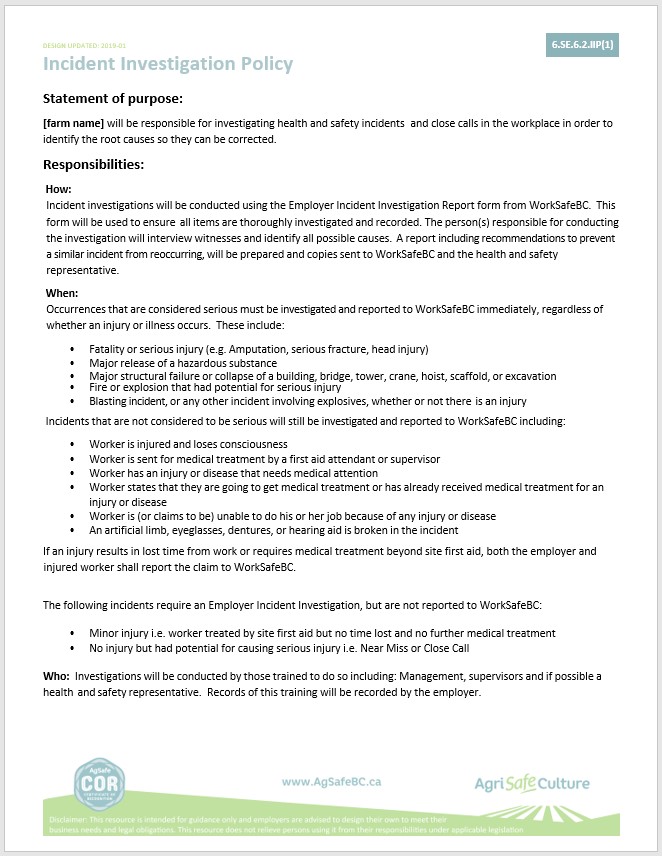
Download: Incident Investigation Policy
The biggest reason for investigating an incident or accident is to prevent the same type of accident from happening again.
Look for Facts, not Fault.
Learning what happened, and how to prevent another accident saves time, saves money and can save lives.
There are some specific requirements in the WorkSafeBC regulations that address when an employer must investigate an accident or incident at a workplace. These are listed in the Policy Statement above. As a general rule, you must investigate and document the investigation when any of the following happens:
- a worker is injured and requires or is sent to medical treatment beyond first-aid at your site,
- a worker is unable to do his or her job because of an injury or disease,
- a major release of a hazardous substance
- a structural failure or collapse of a building, bridge, tower, crane, scaffold, or excavation
- a fire or explosion.
Note that a worker injury does not have to happen for WorkSafeBC to require an incident investigation.
If an incident has just happened, the first priority is to eliminate any clear hazards that still exist and to tend to anyone injured.
Then, get a copy of the Employer Incident Investigation Report (EIIR) form available from WorkSafeBC.
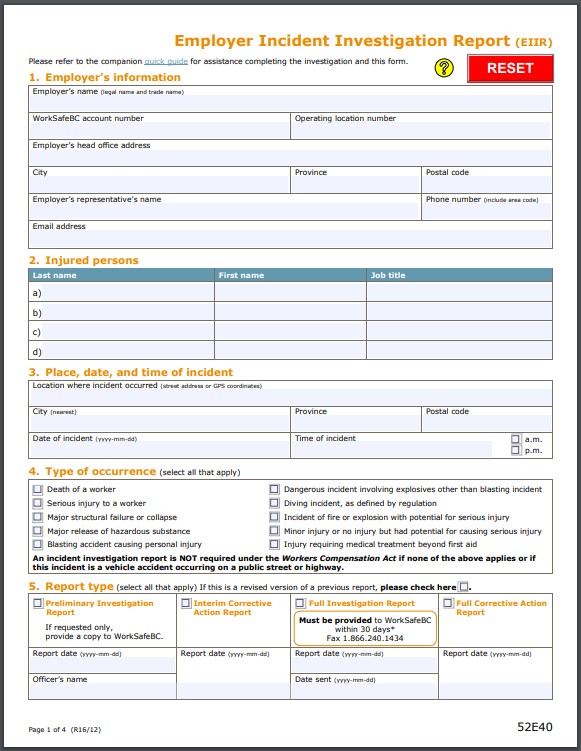
Download: Incident Investigation Form (WorkSafeBC)
The EIIR form is the best resource for capturing all the necessary information and for documenting corrective actions to prevent a similar incident from happening again.
A representative of the employer and a worker should conduct the investigation together. If a Joint Health and Safety Committee is in place at your workplace, at least one member of the investigation team should be on the committee.
Most incidents must be investigated within 48 hours of the employer being made aware of the incident. This is called the “Preliminary Investigation”. Following that a full Incident Investigation must be completed within 30 days of the incident. Here’s a handy flowchart that shows requirements for each of the investigation steps:
Download: Workplace Incident Flow Chart
Additional resources:
Training on how to conduct workplace incident investigations is available from AgSafe. Contact your Safety Consultant or Safety Advisor to discuss our training and safety awareness sessions. Our team is ready to support all agriculture employers to keep your team safe.
WorkSafeBC has specific resources to assist with workplace investigations. See their Incident Investigation resource page for more information:
https://www.worksafebc.com/en/health-safety/create-manage/incident-investigations
Every person at a workplace, a supervisor, owner, or worker has an obligation to work safely, and to support a safe workplace. A Joint Health and Safety Committee brings together workers and employer representatives to identify and help resolve workplace health and safety issues.
Let’s look at who needs a Joint Health and Safety Committee (JHSC), what they do, and how AgSafe can support your committee.
Who needs a joint health and safety committee?
If your workplace has 20 or more workers you need a joint committee. This includes any workplace where there are 20 or more workers employed at the workplace for longer than a month.
If your workplace has more than 9 workers but fewer than 20 workers, you need to have a worker health and safety representative. This includes any workplace where there are 10 or more workers employed at the workplace for longer than a month.
What does a joint health and safety committee do?
The joint health and safety committee gives workers and employers a structured way to work together to identify and find solutions to workplace health and safety issues. The duties and functions for committee members are specified in the WorkSafeBC regulations and the Workers Compensation Act.
Some of the key duties include:
- Identifying situations that may be unhealthy or unsafe for workers.
- Considering & promptly dealing with complaints relating to the health and safety of workers.
- Consult with workers and the employer on issues related to occupational health and safety.
- Make recommendations to the employer and workers for the improvement of occupational health and safety.
- Participate in inspections, investigations and inquiries as required.
For details on the other duties and responsibilities, talk with your AgSafe representative or see the links below.
Is there training required to be a committee member?
Yes! WorkSafeBC requires all new committee members to receive specific training. It includes an overview of committees, the regulations, how they function and their role in the workplace. Also required for new committee members is training for Workplace Inspections and Incident Investigations.
We hire seasonal workers. What about our workplace?
A joint committee must meet “regularly”. WorkSafeBC normally defines this at once per month.
If you hire seasonal workers and the total number of employees will increase to greater than 20 for more than one month, then you will require a safety committee. It should meet as soon as can be arranged after the new workers are hired. How often to meet after that? The minimum is once per month, however it can be more frequent if there are new hazards, a new workplace, or new procedures that the committee should review.
How many people on a committee and how are they picked?
The minimum number is four. Two employer representatives chosen by the employer, and two worker representatives chosen by the workers. The worker representatives should be workers who do typical duties required at your farm and if possible, from different shifts.
How do I learn more?
Talk with your AgSafe Safety Consultant or Safety Advisor. We can help your team with initial joint committee training for new members and with having efficient and effective meetings.
AgSafe has developed a workbook to accompany our in-person training. It’s available to view here.
WorkSafeBC has resources for safety committees as well. Start with this one.
More information and details on the applicable rules and regulations for safety committees is available on the Safety Committee page on the WorkSafeBC website.
We know agriculture producers are always looking to improve. Improve yield, improve animal outcomes, improve the land, and improve the business of your farm or ranch. Just like your business, your safety program will also have room for improvement.
Now that you’ve started your safety program the best way to keep it working for you, is regular review and updating to reflect any changes in operation, processes or hazards.
The Foundations of Safety series began in February with a question - Is your Occupational Health & Safety program paying off? Over the last eight months we’ve presented the core elements of a safety program along with important information, some regulatory requirements, and templates to help you develop and grow your program.
The first step of the program was a promise. A broad promise to your entire team, family, friends and workers. Your Occupational Health & Safety Policy is that promise.
After that first step we provided a wide range of tools for your program to help you develop and grow a working safety program specific to the needs of your organization.
So let’s check in.
The key components of the program are:
- Leadership and Commitment
- Hazard Identification and Control
- Safe Work Procedures and Written Instructions
- Training & Instruction of Workers
- Inspection of Premises, Equipment, Workplace
- Incident Investigation and Reporting
- Joint Health & Safety Committees
Now comes the most important part of the entire process. Keeping the program alive!! Don’t just put all of your research, documents and records in a binder on the shelf collecting dust.
Things can change on your farm or ranch from year to year. Equipment, tools, processes, staff, fields or buildings in use, transportation of workers, animals and crops, and so much more are constantly changing.
With each update, change or growth on your farm review the parts of the safety program that apply. WorkSafeBC has several specific requirements to annually review parts of your program including first aid records, Safety Committee, personal protective equipment (PPE), training and education, and other requirements.
AgSafe has an Annual Review document to help:
This is designed to be used at least once a year but can be used more often if there are significant changes to your operation. One of the key components is the ‘Corrective Action Items’ field. It’s important to record what you’re working on specific to the health and safety of your workers. The Action Plan Template can help track your progress on those items.
Certificate of Recognition (COR)
With a developed and implemented effective safety program in place you may be eligible for a safety Certificate of Recognition. This is a voluntary process that rewards employers who are committed to reducing workplace injuries and encourages worker participation. COR certification is offered by WorkSafeBC and delivered through AgSafe for employers in the agricultural industry.
Information on COR, your potential rebate, a health and safety program self-assessment tool, and more, is available here.
COR certification is the natural next step of your existing health and safety program. To see if your program is ready contact our office. Our Consultants or Advisors can help you fill in any gaps in your safety program and determine if now is the right time to take part in the COR program.
AgSafe Safety Consultants or Safety Advisors are available to help British Columbia agricultural producers with the development and implementation of your safety program. Contact our office to get in touch with a Consultant or Advisor in your area.
So you have been following our “Foundations of Safety” articles over the past year and using them to develop a very robust, functioning health and safety management program for your worksite. Congratulations! You should be proud. You’ve put in a lot of time and hard work to make sure that your workplace is safe for your employees.
It has all come together and is working and you will maintain and improve on the program year to year. You are ready to go to the next level and achieve your Certificate of Recognition (COR) in Occupational Health & Safety. The COR program is a natural extension of your existing health and safety program and this is how it works.
Steps to COR certification:
- Conduct a self-assessment of your current Health & Safety Management System (HSMS) using our free online COR Safety Ready Self-Assessment Tool. This resource will help to identify any deficiencies or gaps in your program, saving you time and money.
- Register for the COR program AgSafe is a WorkSafeBC COR certifying partner and our regional Safety Consultants and Advisors will work with you to do a review of your health and safety management system to see if it meets the COR audit standards. If there are any areas of your program identified as needing improvement, AgSafe can assist by providing one-on-one guidance and resources.
- If an employer feels that their HSMS is ready for a COR audit AgSafe will provide internal auditor training for small employers (19 or less employees) or direct large employers (20 or more employees) to hire an approved AgSafe external auditor for their Certification year.
- During the audit AgSafe is available to provide guidance and answer any questions about how to execute the audit.
The audit consists of:
- Documentation Review
- Observations (Large Employer only)
- Interviews of staff
- Audit Report and Tool writing
The audit will go through an official review process before being approved for COR Status. Once the audit has been approved the employer will be officially COR certified and receive and annual incentive payment the following year from WorkSafeBC based on premium payments.
Over time, with reduced injuries and lower claim costs, a COR certified company’s experience-rated WorkSafeBC premiums will reflect additional savings.
In order to maintain COR status maintenance audits must be performed annually. These audits are to encourage development and continual improvement of an effective health and safety management program.
We are here to help you. Click here to find out who the AgSafe Safety Consultant or Advisor is for your region, or contact our office toll-free 1-877-533-1789.

